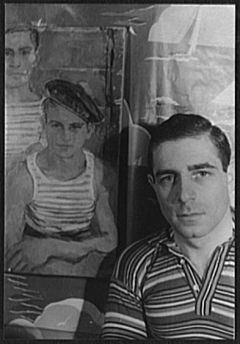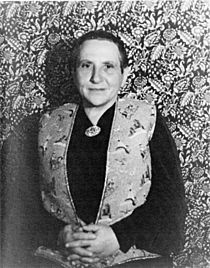Virgil Thomson facts for kids
Quick facts for kids
Virgil Thomson
|
|
|---|---|

Thomson in 1947, photographed by Carl Van Vechten
|
|
| Born | November 25, 1896 Kansas City, Missouri, U.S.
|
| Died | September 30, 1989 (aged 92) Hotel Chelsea, Manhattan, New York City
|
| Occupation | Composer, critic |
| Years active | 1920–1989 |
| Awards | National Medal of Arts Kennedy Center Honors Pulitzer Prize for Music |
Virgil Thomson (born November 25, 1896 – died September 30, 1989) was an American composer and critic. He helped create a special "American Sound" in classical music. People described his music as modern and sometimes like older styles. He was known for keeping his feelings hidden in his music, until his later opera Lord Byron, which showed more strong emotions.
About Virgil Thomson's Life
His Early Years and Studies
Virgil Thomson was born in Kansas City, Missouri. As a child, he became friends with Alice Smith. Her great-grandfather was Joseph Smith, who started the Latter-day Saint movement. Young Virgil often played the organ at Grace Church, where his piano teacher was the organist.
After World War I, he went to Harvard University. A loan from Dr. Fred M. Smith, Alice Smith's father, helped him attend. Thomson's trips to Europe with the Harvard Glee Club made him want to go back there. At Harvard, he studied the piano music of Erik Satie.
He later studied in Paris for a year on a special scholarship. After finishing school, he lived in Paris from 1925 to 1940. While studying there, he was inspired by French composers from a group called "Les Six." These included Darius Milhaud, Francis Poulenc, Arthur Honegger, and George Auric. He also studied with the famous teacher Nadia Boulanger. Thomson became a well-known person in the art scene of "Paris in the twenties."
In Paris in 1925, he became very close friends with the painter Maurice Grosser. Grosser was a frequent partner in his creative work. Later, Thomson and Grosser lived at the Hotel Chelsea in New York. This place became a lively gathering spot for many important people in music, art, and theater. Famous guests included Leonard Bernstein and Tennessee Williams. Thomson also helped many younger composers and writers, such as Ned Rorem, Lou Harrison, and John Cage. Maurice Grosser passed away in 1986, three years before Thomson.
Working with Gertrude Stein
One of Thomson's most important friends from this time was Gertrude Stein. She was a creative partner and a guide for him. After meeting Stein in Paris in 1926, Thomson asked her to write the words for an opera he wanted to compose. Their teamwork led to the first performance of the amazing opera Four Saints in Three Acts in 1934. This opera was special for its unique style, music, and because it featured an all-black cast playing European saints.
Years later, in 1947, he worked with Stein again on his opera The Mother of Us All. This opera told the story of the social reformer Susan B. Anthony. Thomson used parts of Baptist hymns, old church chants, and popular songs in both operas. He also used a careful amount of musical tension.
Music for Films
Thomson's musical talents were not only for operas. In 1936, he worked with film director Pare Lorentz. He wrote music for the documentary film The Plow That Broke the Plains. This film was made for the United States government. Thomson used folk songs and religious music in the film score. Later, he created an orchestra piece from this music. It was recorded by Leopold Stokowski and the Hollywood Bowl Symphony Orchestra in 1946.
In 1938, he also worked with Lorentz and singer Thomas Hardie Chalmers on the documentary film The River. This film was for another government agency. Thomson made an orchestra piece from this score too.
Later, in 1948, he worked with director Robert J. Flaherty on the film Louisiana Story. For this work, Thomson won the Pulitzer Prize for Music in 1949. At that time, it was the only Pulitzer Prize for music given for a film score. The orchestra piece based on this film score was first played by Eugene Ormandy and the Philadelphia Orchestra in 1949. It was very popular with critics.
Music Critic and Mentor
After writing his book The State of Music, Thomson became a well-known figure in New York City. He was also a music critic for the New York Herald-Tribune newspaper from 1940 to 1954. He often encouraged new music and younger composers.
Thomson became a kind of mentor to a new group of American composers. These included Ned Rorem, Paul Bowles, and Leonard Bernstein. They shared similar ideas about how to compose music.
Awards and Honors
Thomson received many important awards. In 1949, he won the Pulitzer Prize for Music for his film score for Louisiana Story. In 1983, he received the Kennedy Center Honors award. In 1988, President Ronald Reagan gave him the National Medal of Arts. He was also a National Patron of Delta Omicron, a music group.
His Final Years
Virgil Thomson passed away on September 30, 1989, at the Hotel Chelsea in Manhattan. He was 92 years old. He had lived at the Chelsea for almost 50 years.
Virgil Thomson's Musical Works
Symphonies
- Symphony on a Hymn Tune (1928)
- Symphony No. 2 in C major (1931, revised 1941)
- Symphony No. 3 (1972)
Operas
- Four Saints in Three Acts, words by Gertrude Stein (1928)
- The Mother of Us All, words by Gertrude Stein (1947)
- Lord Byron, words by Jack Larson (1966–1968)
Ballets
- Filling Station with dancing by Lew Christensen (1937)
- Parson Weems and the Cherry Tree with dancing by Erick Hawkins (1975)
Film Scores
- The Plow That Broke the Plains – Suite (1936)
- The River – Suite (1938)
- Louisiana Story Suite for a film by Robert Flaherty (1948)
- La Deesse (1958)
Orchestra Music
- Three Pictures for Orchestra (1947–1952)
- Five Songs from William Blake (1951)
- Concerto for Flute, Strings, harp and Percussion: A Portrait of Roger Baker (1954)
- Concerto for Cello and Orchestra (1950)
- Crossing Brooklyn Ferry based on poems by Walt Whitman (1958, arranged 1961)
- Mass (1960, arranged 1962)
- Pilgrims and Pioneers (1964)
- The Feast of Love based on the poem Pervigilium Veneris for baritone and chamber orchestra (1964)
- Cantata on Poems of Edward Lear (1973–1974)
- Eleven Portraits for Orchestra (1981–1982)
Piano Music
- Nine Portraits (1930–1969):
- Madame Dubost chez elle (1930)
- Russell Hitchcock, Reading (1930)
- Ettie Stettheimer (1935)
- Helen Austin at Home and Abroad (1935)
- A French Boy of Ten: Louis Lange (1938)
- Pastoral: A Portrait of Tristan Tzara (1940)
- Awake or Asleep: Pierre Mabille (1940)
- Prisoner of the Mind: Schuyler Watts (1942)
- For Eugene Ormandy's Birthday, 18 November 1969
- A Study in Stacked-Up Thirds (1958, revised 1969)
- Ten Etudes (1943–1944)
- Nine Etudes (1951)
Chamber Ensemble Music
- String Quartet No. 1 (1931, revised 1957)
- String Quartet No. 2 (1931, revised 1957)
- Sonata da Chiesa (three movements), for clarinet, trumpet, horn, trombone, viola (1926)
- Four Portraits, for cello and piano arranged in 1942 by Luigi Silva:
- Bugles and Birds (Pablo Picasso) (1940)
- Tango Lullaby (Flavie Alvarez de Toledo) (1940)
- In a Bird Cage (Lise Deharme) (1940)
- Fanfare for France (Max Kahn) (1940)
Images for kids
See also
 In Spanish: Virgil Thomson para niños
In Spanish: Virgil Thomson para niños






